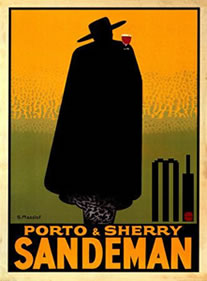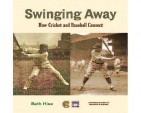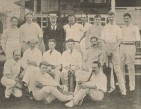O Jogo do Cricket em Portugal
Alex Fensome |
Moises Henriques, an exciting young all rounder from New South Wales, recently became the first Portuguese to play international cricket when he took the field for Australia in the one-off 2020 international against New Zealand. Henriques was born in Funchal, the capital of the island of Madeira and a place better known for producing footballers such as Cristiano Ronaldo, but only spent the first year of his life there before his parents emigrated to Australia, joining the worldwide Portuguese Diaspora. Henriques cannot be claimed as a poster boy for cricket in Portugal, lampooned by the restaurant chain Nando’s adverts that blighted the 2005 Ashes series for Channel 4 viewers, but he is a new chapter for the history of Portuguese cricket, a history that in fact goes back many years.
The first known games of cricket in Portugal were between British troops fighting in the country during the Peninsula War (1808-1814). Games took place in the army encampments outside Lisbon. The sport did not catch on amongst the Portuguese soldiers; though I would not be at all surprised if a Portuguese officer or two tried their hand at the game, as they did other English pursuits such as fox hunting.
Portugal and England have in fact been allies since 1373; the oldest diplomatic alliance in the world; trade and cultural contact between the two nations has been commonplace ever since. English princesses married in to the Portuguese royal family and vice versa. There has long been a significant British presence in Portugal. During the War of the Spanish Succession at the turn of the 17th Century, it became difficult for English traders to import wine from the continent, due to a French trade embargo; they began to turn to their Portuguese allies’ national drink vinho do Porto as an alternative; the fortified wine soon became popular in Britain, leading in time to the establishment of the British-owned port lodges in the city of Porto itself; it was here that cricket was to find a measure of popularity.
Anyone who likes port as a drink knows the names of many of the British-owned lodges based in Vila Nova de Gaia, across the Douro from the city of Porto; Burmester’s, Sandeman, Croft, Churchill, Cockburn Smythes, Forrester, Graham, Osbourne, Smith Woodhouse, Symington’s, Taylor Fladgate & Yeatman, Warres. Some of these companies were founded as early as the 1670s, and they formed the core of a large British community in Porto that endured until the dark days of the Salazar Dictatorship. They formed a largely self-contained Anglophone society; a slice of England transported to Portugal. They indulged in the customs of their homeland; horse-racing, tennis, and of course cricket.
The Oporto Cricket Club was founded in 1855; Founder members included a Sandeman, a Fladgate and a Warre. Five years later, Britons based in Lisbon founded the Lisbon Cricket Club and the next year, 1861, Lisbon hosted the Oporto side and lost. The same fixture has been played almost every year since, with Oporto holding the balance of results. These two clubs were, however, extremely exclusive institutions and there was never any real intention to spread the game amongst the Portuguese themselves. Very few natives played at either club, and neither were teachers encouraged to take the game to their institutions as happened in Denmark and other countries. Even today a glance at the Oporto CC website suggests an aura of exclusivity and tradition around the place. With little effort made to include the Portuguese, it was inevitable that cricket failed to take off in the country.
Early opponents for the two Portuguese clubs included sides drawn from the British naval ships who used their allies’ deep water harbours in Porto and Lisbon for repairs (in fact, the name Portugal derives from “portu cale” which is Latin for “safe harbour”). The naval sides tended to win easily. The Lisbon club had to move their ground at the end of the 19th century to make way for the Lisbon bullring- the ostentatious Campo Pequeno on the Avenida da Republica to the north of Lisbon’s beautiful and eccentric city centre. Homeless, they were forced to move several times before finding a more permanent home in the suburb of Carcavelos, where the club is still based today.
In 1910, a team including Sir Pelham Warner played against both sides, and in 1924 Cryptics CC, an Oxford Old Boy’s team toured for the first time- they have continued to do so every year until the present day. In 1934, H.G. Leveson-Gower led his picked men to Portugal, including a few county cricketers; they were the strongest side yet seen. Other gentlemen’s XIs toured over the years and players such as Percy Perrin of Essex, Percy Fender and RC Robertson-Glasgow visited the country. However, once again, we are talking of very exclusive teams composed of the upper classes which made no effort and had no inclination to spread the game in Portugal.
In 1907, a sports club was founded in the Porto suburb of Leixoes, the docks at which the port wine is loaded into ships for transport. Leixoes hosted several different sports including tennis, basketball, football and cricket in their early years; though no records are available of their cricket side, it would appear that at least some native Portuguese were playing the game here- the club seems to have been founded in imitation of the British sports clubs in the city. Leixoes soon became focused upon football, and today they are enjoying something of a Golden Era in the Portuguese Liga. However, their history as a multi-sports team is remembered in their club badge, which consists of a basketball, a tennis racket and- astonishing me when I first saw it- a cricket bat. Also in 1907, some young Portuguese gentlemen in a suburb of Lisbon decided to found a sports club. Needing equipment and short of money, they purchased a second-hand football for one and half escudos from the Lisbon Cricket Club. The club was named after the suburb; Benfica.
In this era of the expatriate and mass immigration, cricket has expanded in Portugal. There are several clubs catering for Britons in the Algarve, for example, and a few teams of Asian Portuguese (some Goans, others from Pakistan and wider India). Cricket in Portugal even has a governing body, the Federacao Portuguesa de Cricket, and their national side, containing mainly expatriates, has put in good showings against other minor European sides, even winning the European Indoor Championship in 2001, defeating the Netherlands, a country with a far better pedigree. Outside, they won the 2001 ECF Trophy for the minor cricketing nations of Europe and appeared at the European Cricket Championship in 2002. The hope is that more native Portuguese will be seduced by the game and eventually the Portuguese team will become one of the leading European nations.
I am going to be brutally frank here and say that there is no chance whatsoever of the Portuguese taking to cricket in any major way; football is their religion, to an extent that is frightening even compared with British standards. It is really the fault of the early cricketers for not trying to bring the Portuguese into the game and maintaining it as an “English” game played by the “English”. Given the long period of friendship and mutual admiration between Britain and Portugal it seems a shame that this should be the case for of all the countries in Europe, Portugal was surely the most likely, circa 1850, to take to an English game.
As well as Moises Henriques, there have in fact been several international cricketers of Portuguese ancestry thanks to their long imperial history. After Mozambique and Angola gained their independence following the Carnation Revolution of 1974 many Portuguese colonists, rather than face the ridicule and social stigma that awaited them in the motherland as retournados, fled to Rhodesia and South Africa; here, they form a minority of the white population; it is also important to remember that a section of the early white population of the Cape Colony- the original Afrikaners- were Portuguese. Ferreira is a common name in South Africa, and a glance at the list of South African first-class cricketers will reveal da Costas and Ferreiras and alongside the van der Merwes and the Bothas. Basil D’Oliveira’s name recalls a distant ancestor who had seen the banks of the Tagus. Neil Ferreira, a Zimbabwean, even played test cricket. Several West Indians of Portuguese descent have worn the maroon cap; RK Nunes, MP Fernandes, OC da Costa, FI de Caires, IL Mendonca, even Larry Gomes would be called Larry Gome-esh in Portugal! Sir Errol dos Santos was also President of the West Indies Cricket Board for many years.
Portugal’s once extensive possessions in Asia have also left a rich crop of Lusitanian surnames in the Indian Subcontinent. Their long-time colony of Goa has not produced many cricketers of note, but Antao d’Souza, possessor of a classically Portuguese name, played Tests for Pakistan, as did his fellow Goan Wallis Mathias. Two other Goans in Dilip Sardesai and Paras Mhambrey played for India. Any Sri Lankan scorecard, of course, reveals the island’s history as a Portuguese colony- de Silva, Fernando, Perera, Mendis. So whilst Moises Henriques is the first Portuguese-born international, Portugal has, genetically at least, produced several cricketers of note. In fact, we might be able to create a Portuguese XI:
Neil Ferreira (Zimbabwe)
Duleep Mendis (Sri Lanka)
Aravinda de Silva (Sri Lanka)
Larry Gomes (West Indies)
Basil D’Oliveira (England)
Moises Henriques (Australia) * (as the only Portugal-born player)
Ashley de Silva (Sri Lanka) +
Antao d’Souza (Pakistan)
Ruchira Perera (Sri Lanka)
Dilhara Fernando (Sri Lanka)
Ajantha Mendis (Sri Lanka)
This side leaves out many other excellent Sri Lankan players gifted with a Lusitanian surname. I will leave it for the reader to decide how “Portuguese” these players actually are!





I hate to be a pedant, but Henriques was beaten to it by over 50 years. The first Portuguese-born test player was South Africa’s Dick Wescott, who enetered the world in Lisbon.
Comment by Dale Brumby | 12:00am GMT 29 March 2009
Correct – but Henriques was native-born Portuguese whereas Westcott wasn’t, which is why he isn’t mentioned here.
Comment by Chubb | 12:00am BST 30 March 2009
As the current portuguese national wicketkeeper, I was chuffed to read an article on cricket in portugal. As the sole player of European Portuguese decent (Born a Brummie for my sins) in the current squad. I was pleased to see the rise of young Henriques for the Australians, he share my Island heritage and thus not the first Madeiran to play in an international match!
Your article sadly fails to mention the Kendall Cup which has been an annual fixture played between Lisbon and Porto since 1920…
Comment by Jay da Costa | 12:00am GMT 8 November 2009
My name is Frank Rogerson and I am the present Captain of the Oporto Cricket team. Parabens for your article which has been well researched.
This year is the 150th anniversary of the first cricket fixture that you mentioned between Oporto and Lisbon. In 1920 a cup was presented for the first time by Albert C. Kendall in memory of his cousin Lt. Douglas Rawes who sadly was kllled in WW1.
The fixture has since been played for the \”Kendall Cup\”.
It has been played most years since 1861, and is one of the oldest, if not the oldest annual fixture played on Continental Europe.
This year we will celebrate 150 years!
Please contact me if you are interested in more details.
Comment by Frank Rogerson | 12:00am GMT 28 February 2011
It may be of interest to players that there is now a Cricket Club in Coimbra (central portugal) based at the Miranda do Corvo Stadium. http://www.coimbraportugal.cc
Comment by Coimbra Cricket Club | 12:00am BST 31 March 2014
In 1907, Benfica was part of Lisbon, it wasn’t a suburb.
Comment by Bnm | 12:00am BST 30 July 2014